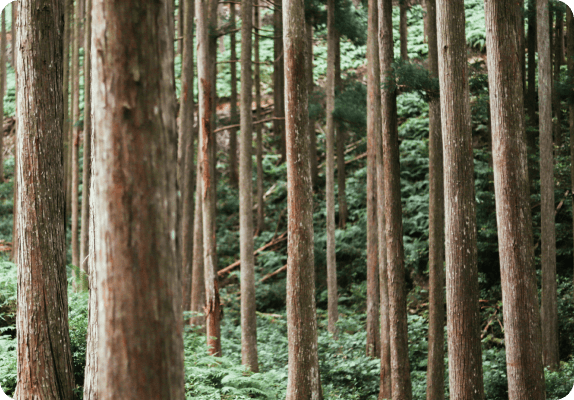FEATURE
01
Owase Cypress Forestry with
History and Tradition

02
Rich Fishing Grounds Formed by the Surrounding
Mountains and Ocean

03
Next-generation Education Based on the
Natural Environment

PROJECT
Community Forests as New Commons

Keep Involved with Nature
In Japan, where forests cover 70% of the national land, most of them have been modified by human activities and maintained as “satoyama,” including planted forests. “Satoyama” is neither completely natural nor completely controlled by humans, and with moderate human activity intervention, it has been utilized for the coexistence of humans and nature as a place where the diversity of plants and animals is greater than in primary forests or urban areas, rich ecosystems are maintained, and biodiversity is preserved. However, in Japan, a country with a shrinking and super-aged population ahead of the rest of the world, former satoyama have been abandoned, and the cost of managing them has gradually come to be regarded as a “liability” for economic reasons. As a result, planted forests are not properly managed, and various problems such as landslides, river floods, declining fish catches, and declining numbers of native species are affecting local livelihoods. SINRA and the people of Owase will work together to develop healthy satoyama that efficiently absorbs CO2 and protects biodiversity. Furthermore, we will create regenerative natural resources and a local economy by training and employing people who can maintain the local commons while working between the forest and the ocean.
Social Impact
Restoration of Soils
contributing to Biodiversity
Creation of Local Employment
Establishment of a School to
Adapt to a Regenerative World
We hope to generate a co-benefit which can create a community that will last for 100 years by preserving the rich natural environment and creating a place for learning that utilizes the entire environment as a campus. As an alternative to the current educational system, we will create a new 'school' where all generations can continue to learn by developing their individual characteristics and deeply engaging with nature. By using the forest, the ocean, and the entire town as a campus, we will satisfy diverse interests and create learning, employment, and livelihoods that adapt to a regenerative world, thereby fostering a community-wide perspective that considers the future of society with all ecosystems in mind.


Water Vein Creation. This is the procedure of digging trenches in hardened ground to allow rainwater to infiltrate into the soil. Branches and stones are placed to prevent collapse of the soil. By allowing rainwater to infiltrate firmly into the soil, water containing minerals from the mountains will pour into rivers and the ocean without cutting away the topsoil, thus preserving a rich ecosystem.

Charcoal is used to improve the soil. Excess organic materials such as rotting logs, branches, and leaves in the forest are removed and carbonized. These become good quality soil improvement materials. Adding charcoal to the soil allows for carbon storage, and the charcoal itself becomes a home for microorganisms, and the mycelium loosens up the stiffened soil.

By bringing light into the forest and restoring the flow of water and wind, we will create an environment where diverse organisms from microorganisms to the top of the ecosystem can survive. Adding humans as part of this process and increasing the amount of life will create a "satoyama" that will lead to the happiness of the people living in the community.

By maintaining the mountains and planting trees appropriate to the land, we are creating a foundation that will nurture a wide variety of plants and animals over a period of 100 years. This is also an important means of protecting the region from disasters, and at the same time, an essential step toward enriching the ecosystem as a whole.
